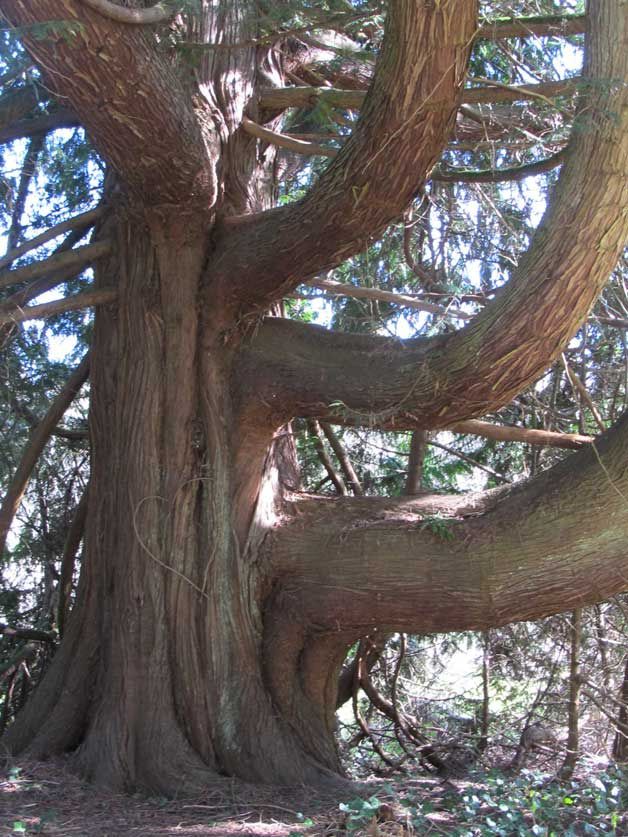Trees offer more than clean air, beauty and a place to sit on a hot summer’s day.
Upon taking a closer look, a tree may be the key into the past.
Like the maple tree on the public access trail at the end of Broom Road. Right there, a Fourth of July celebration occurred in 1861.
That big Western red cedar at the north end of Taylor Road? It’s listed on the National Registry of Historical Trees.
And there are plenty more like those if one cares to ask or inquire. In fact, the folks at the Historic Preservation Commission hope people will ask.
Better yet, the commission wants to see more trees added to the 14 already listed on the local Heritage Tree Program.
“I just kicked it [the program] off with the three trees here,” said Rick Chandler.
As curator at Bainbridge Island Historical Museum, Chandler takes a special interest in the trees.
The older, the better, he thinks.
Chandler was the first to nominate any trees for the prominent list back in 2006. He regularly sits in on Historic Preservation Commission meetings, especially when it involves tree chatter.
When Chandler looks at trees, he sees a piece of history waiting to be revealed.
The ones on the property of the historical museum certainly do. Chandler’s research helped him conclude that the three trees — a sycamore, American elm and red oak — were planted in 1880 as seedlings. If his research is correct, the now massive trees were transported over from English gardens. The largest one is the American elm, standing at 64 feet.
Currently, Chandler is looking at nominating an orchard on the property of Joe and Beth Claseman, the couple who recently received the Blakely Project of Excellence Award for their work to preserve the McRedmond Cabin.
The property itself is 150 years old, which automatically impressed Chandler.
Then, he found out they’ve got a large orchard of 27 trees that were harvested for mill workers years ago, Chandler said. Fruit trees aren’t uncommon to list on the register, as a fruit tree orchard was added last year, he said.
“I like the history that’s around the orchard trees,” he said. “It does tie into really super early history of the island.”
Another gem on the property is a large red cedar with massive branches that twist and turn every which way.
“It’s strangely shaped,” he added.
Despite it being on private property, the Clasemans are open to him doing research and invited him to take a look at the trees on the property.
“I’m planning on doing them both [orchard and cedar]. I don’t want to lump them together because they’re distinctive. I think individual trees deserve a singular status.”
Trees on the local historic listing must be nominated and presented to the Historic Preservation Commission for approval. Some of the valued characteristics of heritage trees include uncommon genus, species, cultivar, form, size and location. Historic, cultural or habitat significance are also highly recommended for nomination. Individuals may nominate trees on a rolling basis, but if the tree stand or tree is on private property, the owner must agree to the nomination prior to submission.
An arborist, usually Olaf K. Ribeiro, then looks at the health of a tree or trees, declares it healthy and the tree is then added to the registry.
For him, trees are a part of life on the island so much so that he has offered tree walks since Arbor Day 2001 where he takes people on tours to see the island’s finest trees. Protection of the trees is paramount to keeping those type of walks alive, he added, noting he has been trying his best to preserve island trees since 1981. Construction is one of the ways unique trees end up destroyed, Ribeiro said.
“Over the past few years we have lost several historic trees to development,” he said. “[However], the most recent victory is by a family on Wyatt Way that managed to save the oldest and largest black locust in Kitsap County from a proposed development by going before the hearing examiner. It is one of the few victories we have had to save trees.”
The city once held the reins to the program, but last year, a tree ordinance ad hoc committee recommended the city council adopt a resolution that would pass the Heritage Tree Program from the Community Forestry Commission to the Historic Preservation Commission.
The Bainbridge council voted unanimously to approve the transfer of the Heritage Tree Program.
Ribeiro said it is obvious to him the city isn’t responsible when it comes to taking care of the island’s precious foliage.
“Although we recently started a Heritage Tree program, it is entirely voluntary,” he said. “The city has no interest in protecting historical trees as witnessed by the recent removal of the last two apple trees planted by Wiley Hodgkins, the first pioneer to land on Winslow.”
But, it is with much hope that the commission and islanders can come together to reveal the island’s most historic trees in a way that may preserve nature in the end, like the Clasemans are working on.
“It’s a habitat for birds,” Chandler remarked. “But they [trees] provide shade; they make the atmosphere balanced.”
Ultimately, Chandler hopes he can get other nature and history enthusiasts interested in saving and recording the most historic trees.
“I’ve been looking for ways to reach across the border of Kitsap County,” he said. “These trees have a history.”
For more information, stop by a Historic Preservation Commission meeting held at 2 p.m. on the first Thursday of every month in the conference room at city hall.



